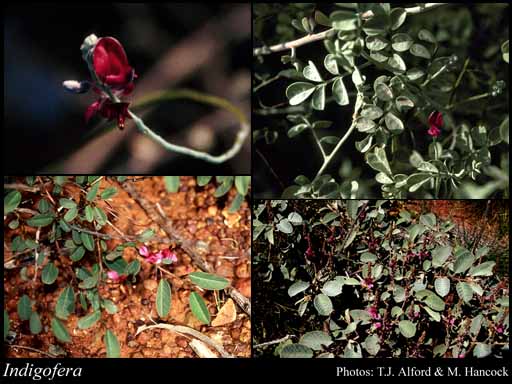- Reference
- Sp.Pl. 2:751 (1753)
- Name Status
- Current

Scientific Description
Family Papilionaceae. Indigoferae.
Habit and leaf form. Shrubs (or subshrubs), or herbs. Plants spiny (via spiny stipules), or unarmed. The herbs perennial; plants with neither basal nor terminal concentrations of leaves; to 0.2–2 m high. Mesophytic, or xerophytic. Leaves alternate; spiral; ‘herbaceous’, or leathery; not imbricate; petiolate, or subsessile; non-sheathing; not gland-dotted; simple (at least ostensibly, e.g. I. haplophylla), or compound; pulvinate; when compound, unifoliolate, or ternate, or pinnate. Leaves when trifoliolate, pinnately trifoliolate. Leaves imparipinnate. Leaflets 1, or 3, or 5, or 7, or 9, or 11 (or more?). Lateral leaflets alternate, or opposite. Leaflets stipellate, or not stipellate; pulvinate, or epulvinate; flat, or folded; without lateral lobes. Leaf blades dorsiventral. Leaves with stipules. Stipules intrapetiolar; shortly adnate to the petiole; free of one another; often small and setaceous, sometimes spinescent. Leaf blade margins entire. Leaf anatomy. Glandular hairs present, or absent. Branched hairs present (biramous, usually). Stem anatomy. Secondary thickening absent, or developing from a conventional cambial ring.
Reproductive type, pollination. Fertile flowers hermaphrodite. Unisexual flowers absent. Plants hermaphrodite. Pollination mechanism conspicuously specialized (explosive).
Inflorescence and flower features. Flowers aggregated in ‘inflorescences’; in racemes, or in spikes. Inflorescences simple. The terminal inflorescence unit racemose. Inflorescences axillary; pedunculate, axillary racemes or spikes. Flowers pedicellate to sessile; bracteate. Bracts deciduous (caducous). Flowers ebracteolate; small; very irregular; zygomorphic; papilionaceous. Floral receptacle with neither androphore nor gynophore. Free hypanthium present, or absent. Perianth with distinct calyx and corolla; 10; 2 -whorled; isomerous. Calyx present; 5; 1 -whorled; gamosepalous; five lobed. Calyx lobes markedly shorter than the tube to markedly longer than the tube. Calyx imbricate, or valvate; exceeded by the corolla; regular, or unequal but not bilabiate, or bilabiate; non-fleshy; persistent; non-accrescent; with the median member anterior. Corolla present; 5; 1 -whorled; appendiculate (the keel petals often spurred), or not appendiculate. Standard not appendaged. Corolla partially gamopetalous. 2 of the petals joined (the anterior pair of petals constituting the ‘keel’), or 4 of the petals joined (the wings often slightly cohering with the keel). The joined petals anterior (or anterior and lateral). The wings of the corolla adherent to the keel, or free from the keel; not laterally spurred. Standard ‘normally’ developed; sericeous, or not sericeous. Keel long-acuminate and beaked (acuminate), or not long-acuminate/beaked; neither coiled nor spiralled; not bent and beaked. Corolla red, or pink, or purple; deciduous; non-accrescent. Petals clawed. Androecial members definite in number. Androecium 10. Androecial sequence determinable, or not determinable. Androecial members free of the perianth; markedly unequal (the filaments alternately long and short); coherent (into an adaxially split tube); 2 - adelphous (9+1, the posterior member free to its base). The staminal tube free from the keel petals. Androecial members 1 -whorled (though diplostemonous). Stamens 10; all more or less similar in shape; diplostemonous; both opposite and alternating with the corolla members. Anthers separate from one another, or connivent; all alike; dorsifixed, or basifixed; versatile, or non-versatile; dehiscing via pores, or dehiscing via longitudinal slits; latrorse, or introrse; tetrasporangiate; appendaged. The anther appendages apical (glandular). Anthers apiculate. Gynoecium 1 carpelled. The pistil 1 celled. Carpels reduced in number relative to the perianth. Gynoecium monomerous; of one carpel; superior. Carpel stylate; apically stigmatic. Style (in-) curved. Style bearded via an apical tuft, or glabrous. Stigmatic tissue terminal. Carpel 1–50 ovuled (to ‘many’). Placentation marginal. Ovary sessile. Ovary summit hairy, the hairs not confined to radiating bands (usually), or glabrous. Stigmas capitate. Ovules arillate, or non-arillate; anatropous, or campylotropous to amphitropous, or hemianatropous.
Fruit and seed features. Fruit 3–40 mm long; sessile; non-fleshy; hairy, or not hairy; spinose, or not spinose (mostly). The fruiting carpel dehiscent; a legume (often with a spotted endocarp). Pods globose to much elongated (usually spreading or descending); not triangular; straight, or curved, or coiled (circinnate, rarely); not becoming inflated; more or less flat, or somewhat compressed (or 3–4 sided), or terete; regularly constricted between adjacent seeds, or irregularly constricted, or not constricted between the seeds; transversely septate between the seeds (with papery or pithy septa); wingless. Fruit 1 celled. Dispersal unit the seed. Fruit 1–15 seeded. Seeds endospermic, or non-endospermic; not mucous; non-arillate. Cotyledons 2; accumbent. Embryo curved, or bent. Testa non-operculate. Micropyle zigzag, or not zigzag. Seedling. Germination phanerocotylar.
Physiology, biochemistry. Nitrogen-fixing root nodules present. Aluminium accumulation not found. Photosynthetic pathway: C3.
Geography, cytology, number of species. Native of Australia. 2n=14, 16, 32, 48. A genus of about 700 species; 28 species in Western Australia.
Taxonomic Literature
- Wilson, Peter G.; Rowe, Ross 2004. A revision of the Indigofereae (Fabaceae) in Australia. 1, Indigastrum and the simple or unifoliolate species of Indigofera.
- Grieve, B. J.; Blackall, W. E. 1998. How to know Western Australian wildflowers : a key to the flora of the extratropical regions of Western Australia. Part II, Dicotyledons (Amaranthaceae to Lythraceae). University of W.A. Press.. Nedlands, W.A..
- Wilson, Peter G.; Rowe, Ross 1994. The Indigofera trita complex (Fabaceae: Indigofereae) in Australia.
- Wheeler, J. R.; Rye, B. L.; Koch, B. L.; Wilson, A. J. G.; Western Australian Herbarium 1992. Flora of the Kimberley region. Western Australian Herbarium.. Como, W.A..
- Wilson, Peter G. 1990. Indigofera psammophila (Fabaceae), a new species from arid Australia.
- Wilson, Peter G. 1987. Taxonomic notes on some Australian species of Indigofera (Fabaceae: Faboideae).